
Search Wild Foods Home Garden & Nature's Restaurant Websites:
Rose Bush for Rose Hips
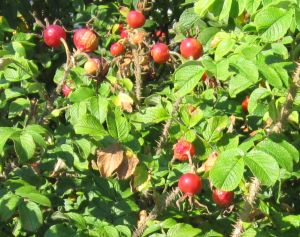
(NOTE: If you are not interested in growing the Rose Bush for Rose Hips, but just finding the Rose Hips and using them, try going to the Nature's Restaurant Online site Rose Hips page.)
Rose Hips, the fruit that grows on Rose (Rosa) bushes after the flower dies, can be quite tart, but that is because they are full of vitamin C.
As far as growing them goes, assuming you wanted to grow Roses anyway, just ask at a knowledgeable nursery which varieties have the largest Rose Hips. Look at the pictures included below the description to see how big they can be. Plant as per instructions from the nursery, and talk to them about pruning and care. There are thousands of varieties that fit every need, climate and growth characteristics possible, but here are the basics that cover the vast majority. Regardless of what I say, always follow the instructions for your particular cultivar.
Soil & Site: First they like to get a lot of sun, but are happier if you can find a spot where they are not in the full sun on summer afternoons. They like soil that is between pH 6.5 to 7.0. They like a well drained, loose organic rich soil. If you soil doesn't fit that description, you might be able to fix it by making a raised bed with the proper soil in it. Though they like well drained soil, they like a good amount of moisture. Some system of watering, whether by hand or drip system should be planned. Do not let them dry out the first season they are planted. The like fertilizer of some sort as they are nutrient hungry plants. A 5-8-5 pellet fertilizer applied per instructions or composted manure at least once per year is needed. Keep an organic mulch around them to keep the moisture in the soil.
Maintenance: Prune out dead or sick growth, keep it open to let air flow. In the fall after the plant has gone dormant, put a thick layer - 30 cm (1 foot) of mulch around the base, and cover with the appropriate cloth if needed. You should discuss how hardy the particular variety is when purchasing. If you tell them you want the largest Rose hips, the least maintenance, disease resistance, and best tolerance to local conditions, this will go a long way to making your life easier. The nursery will like you too - most people just want the biggest, brightest roses that bloom all season, and don't think about the other stuff, then blame the plant or nursery when they find them dead in a year or two.
Harvesting: Late summer to early fall after the flowers have died. Look for orange or red skins, and don't bother if wrinkled looking. They tend to be milder after a frost, but many have gone bad by then as well.
Using: To use the ripe hips, gather, then cut off both ends, cut in half and scrape out all seeds and hairs. I find the larger ones taste better and are easier to clean out using a teaspoon. Make sure you clean them out completely - this is important, as the seeds have arsenic in them and the hairs will get stuck in your throat and mouth. At this point, you can either eat some right away raw, make tea from them raw, dry them out for tea, or use in baked goods or small amounts in stir fry's chopped very small.
Description:
- USDA Plant Hardiness Zone: in general, 3-11, but you must know for your specific variety (More information on hardiness zones).
- Soil pH: in general 5.5-7.0, make sure you check for your specific variety
- Plant Size: From miniature to 7 meters (23 feet) high
- Duration: Perennial
- Leaf Shape: Odd Pinnate - odd meaning a single leaflet at the tip of the leaf making the number of leaflets an odd number. Generally 5-9 leaflets per leaf, but can be a few as 3 or as many as 13
- Leaf Phyllotaxis (Arrangement) on branch: Alternate, though each leaf has Opposite leaflets and a terminal single leaf
- Leaf Size: 5-15 cm (2 to 6 inches) long
- Leaf Margin: Each leaflet is Serrated (saw toothed edge)
- Leaf Notes: Color is variable depending on cultivar, but usually a darker green with some reddish tones and a red stem for the leaflets on the leaf stem
- Flowers: Highly variable in color, size and number of petals
- Fruit: Call a hip, forms right under where flower grows, highly variable in size and taste
- Bark: Green, but can be a woody brown or grey on older branches, most often covered with wide, oval based thorns that curve to a very sharp, hard tip
- Habitat: Most native to China, but most any garden and wild roses found in open woods, sides of woods, fields, fence lines
Web Resources:
- Recipe search on the web here (Google search) and here (Bing search).
- Pictures on the web here (Google images) and here (Bing images).
- Interactive USDA distribution map and plant profile here.
- The Biota of North America Program (BONAP) distribution map here. BONAP map color key here.
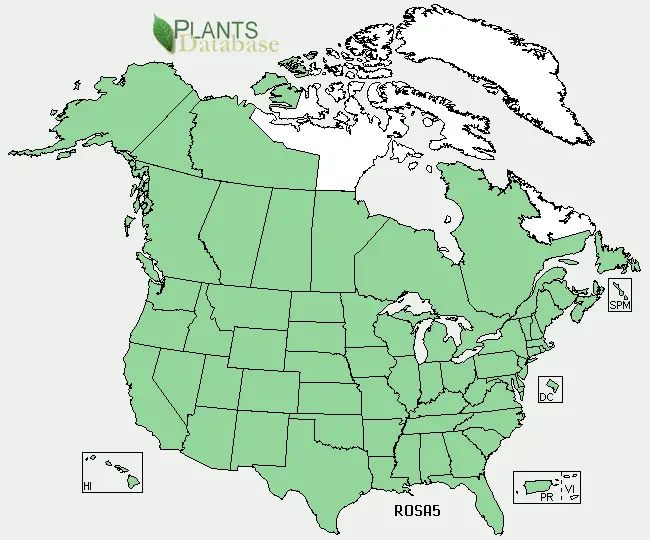
Rose (Rosa) range. Distribution map courtesy of U. S. Department of Agriculture (USDA Natural Resources Service) and used in accordance with their policies.
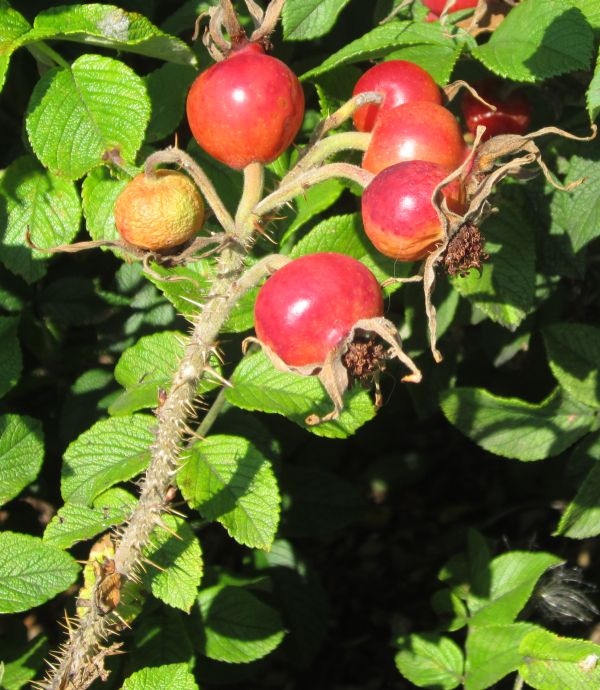
Watch out for thorns when gathering Rose Hips. Notice the wrinkly one on the left of the cluster, leave those.
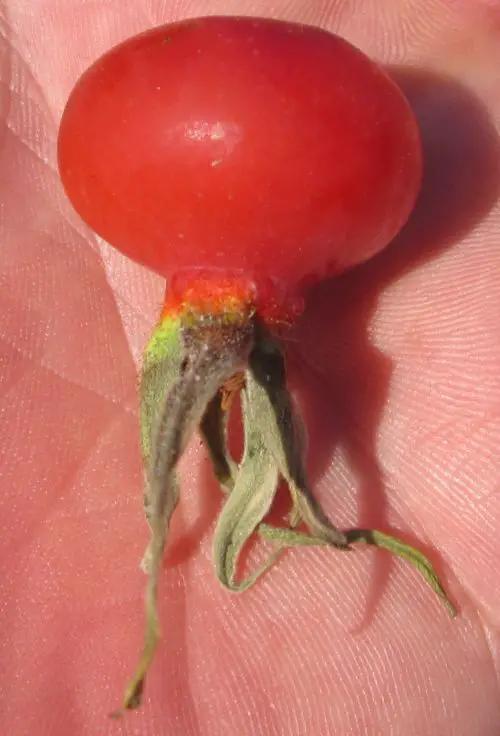
Close up, notice how rose hips often have parts of the dead rose flower left on. When eating, cut in half down center, and scoop out all the seeds and hairs - this is important, so make sure you get it all. The tiny seeds contain arsenic, and the hairs are like tiny spikes that will get stuck in your throat and mouth.
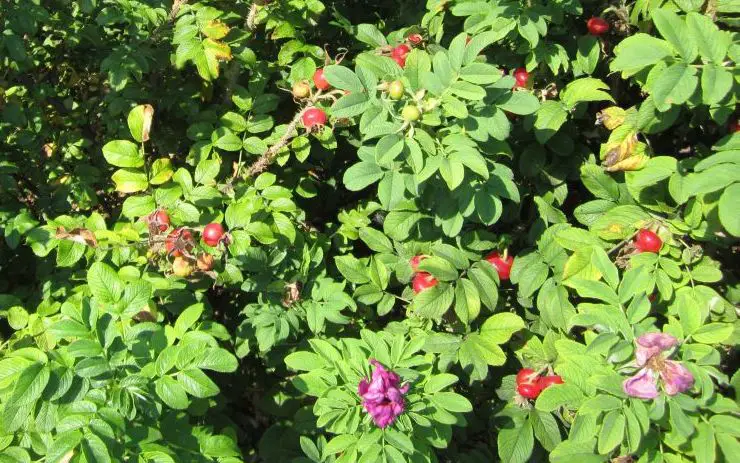
Great crop of Rose Hips with some purple/pink flowers still on bush. Rose hips are a very close relative of the apple.
Search Wild Foods Home Garden & Nature's Restaurant Websites:
Share:
Why does this site have ads?
Originally the content in this site was a book that was sold through Amazon worldwide. However, I wanted the information to available to everyone free of charge, so I made this website. The ads on the site help cover the cost of maintaining the site and keeping it available.
Google + profile
